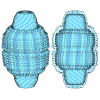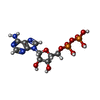+ Open data
Open data
- Basic information
Basic information
| Entry | Database: PDB / ID: 9mxv | ||||||
|---|---|---|---|---|---|---|---|
| Title | Human Vault Cage in complex with ADP | ||||||
 Components Components | Major vault protein | ||||||
 Keywords Keywords | PROTEIN TRANSPORT / Vault / Vault Cage / MVP / Major Vault Protein / SPFH / PARP4 / Poly(ADP-ribose)Polymerase 4 / MINT / ADP / Adenosine diphosphate / Poly(ADP-ribose)Polymerase / Ribonucleoprotein / Megadalton complex / TEP1 / vault RNA | ||||||
| Function / homology |  Function and homology information Function and homology informationnegative regulation of protein tyrosine kinase activity / protein activation cascade / negative regulation of protein autophosphorylation / ERBB signaling pathway / negative regulation of epidermal growth factor receptor signaling pathway / mRNA transport / nuclear pore / protein transport / protein phosphatase binding / secretory granule lumen ...negative regulation of protein tyrosine kinase activity / protein activation cascade / negative regulation of protein autophosphorylation / ERBB signaling pathway / negative regulation of epidermal growth factor receptor signaling pathway / mRNA transport / nuclear pore / protein transport / protein phosphatase binding / secretory granule lumen / ficolin-1-rich granule lumen / cytoskeleton / cell population proliferation / ribonucleoprotein complex / Neutrophil degranulation / protein kinase binding / perinuclear region of cytoplasm / extracellular exosome / extracellular region / identical protein binding / nucleus / membrane / cytosol / cytoplasm Similarity search - Function | ||||||
| Biological species |  Homo sapiens (human) Homo sapiens (human) | ||||||
| Method | ELECTRON MICROSCOPY / single particle reconstruction / cryo EM / Resolution: 2.68 Å | ||||||
 Authors Authors | Lodwick, J.E. / Zhao, M. | ||||||
| Funding support |  United States, 1items United States, 1items
| ||||||
 Citation Citation |  Journal: bioRxiv / Year: 2024 Journal: bioRxiv / Year: 2024Title: Structural Insights into the Roles of PARP4 and NAD in the Human Vault Cage. Abstract: Vault is a massive ribonucleoprotein complex found across Eukaryota. The major vault protein (MVP) oligomerizes into an ovular cage, which contains several minor vault components (MVCs) and is ...Vault is a massive ribonucleoprotein complex found across Eukaryota. The major vault protein (MVP) oligomerizes into an ovular cage, which contains several minor vault components (MVCs) and is thought to transport transiently bound "cargo" molecules. Vertebrate vaults house a poly (ADP-ribose) polymerase (known as PARP4 in humans), which is the only MVC with known enzymatic activity. Despite being discovered decades ago, the molecular basis for PARP4's interaction with MVP remains unclear. In this study, we determined the structure of the human vault cage in complex with PARP4 and its enzymatic substrate NAD . The structures reveal atomic-level details of the protein-binding interface, as well as unexpected NAD -binding pockets within the interior of the vault cage. In addition, proteomics data show that human vaults purified from wild-type and PARP4-depleted cells interact with distinct subsets of proteins. Our results thereby support a model in which PARP4's specific incorporation into the vault cage helps to regulate vault's selection of cargo and its subcellular localization. Further, PARP4's proximity to MVP's NAD -binding sites could support its enzymatic function within the vault. | ||||||
| History |
|
- Structure visualization
Structure visualization
| Structure viewer | Molecule:  Molmil Molmil Jmol/JSmol Jmol/JSmol |
|---|
- Downloads & links
Downloads & links
- Download
Download
| PDBx/mmCIF format |  9mxv.cif.gz 9mxv.cif.gz | 283.6 KB | Display |  PDBx/mmCIF format PDBx/mmCIF format |
|---|---|---|---|---|
| PDB format |  pdb9mxv.ent.gz pdb9mxv.ent.gz | 227.9 KB | Display |  PDB format PDB format |
| PDBx/mmJSON format |  9mxv.json.gz 9mxv.json.gz | Tree view |  PDBx/mmJSON format PDBx/mmJSON format | |
| Others |  Other downloads Other downloads |
-Validation report
| Summary document |  9mxv_validation.pdf.gz 9mxv_validation.pdf.gz | 1.3 MB | Display |  wwPDB validaton report wwPDB validaton report |
|---|---|---|---|---|
| Full document |  9mxv_full_validation.pdf.gz 9mxv_full_validation.pdf.gz | 1.3 MB | Display | |
| Data in XML |  9mxv_validation.xml.gz 9mxv_validation.xml.gz | 74 KB | Display | |
| Data in CIF |  9mxv_validation.cif.gz 9mxv_validation.cif.gz | 111 KB | Display | |
| Arichive directory |  https://data.pdbj.org/pub/pdb/validation_reports/mx/9mxv https://data.pdbj.org/pub/pdb/validation_reports/mx/9mxv ftp://data.pdbj.org/pub/pdb/validation_reports/mx/9mxv ftp://data.pdbj.org/pub/pdb/validation_reports/mx/9mxv | HTTPS FTP |
-Related structure data
| Related structure data | 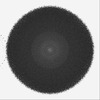 44959MC 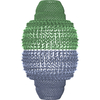 9bw5C 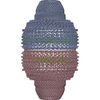 9bw6C 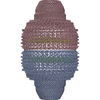 9bw7C 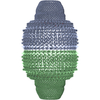 9mxhC M: map data used to model this data C: citing same article ( |
|---|---|
| Similar structure data | Similarity search - Function & homology  F&H Search F&H Search |
- Links
Links
- Assembly
Assembly
| Deposited unit | 
|
|---|---|
| 1 | x 39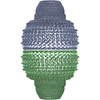
|
| 2 |
|
| 3 | 
|
| Symmetry | Point symmetry: (Schoenflies symbol: C39 (39 fold cyclic)) |
- Components
Components
| #1: Protein | Mass: 99452.766 Da / Num. of mol.: 2 Source method: isolated from a genetically manipulated source Source: (gene. exp.)  Homo sapiens (human) / Gene: MVP, LRP / Production host: Homo sapiens (human) / Gene: MVP, LRP / Production host:  Trichoplusia ni (cabbage looper) / References: UniProt: Q14764 Trichoplusia ni (cabbage looper) / References: UniProt: Q14764#2: Chemical | Has ligand of interest | Y | Has protein modification | N | |
|---|
-Experimental details
-Experiment
| Experiment | Method: ELECTRON MICROSCOPY |
|---|---|
| EM experiment | Aggregation state: PARTICLE / 3D reconstruction method: single particle reconstruction |
- Sample preparation
Sample preparation
| Component | Name: Binary complex of the human vault cage bound to ADP / Type: COMPLEX / Entity ID: #1 / Source: RECOMBINANT | |||||||||||||||||||||||||
|---|---|---|---|---|---|---|---|---|---|---|---|---|---|---|---|---|---|---|---|---|---|---|---|---|---|---|
| Molecular weight | Value: 7.8 MDa / Experimental value: NO | |||||||||||||||||||||||||
| Source (natural) | Organism:  Homo sapiens (human) Homo sapiens (human) | |||||||||||||||||||||||||
| Source (recombinant) | Organism:  Trichoplusia ni (cabbage looper) Trichoplusia ni (cabbage looper) | |||||||||||||||||||||||||
| Buffer solution | pH: 8 Details: 50 mM HEPES pH 8.0, 5 mM CaCl2, 5 mM MgCl2, 0.25 mM DTT | |||||||||||||||||||||||||
| Buffer component |
| |||||||||||||||||||||||||
| Specimen | Embedding applied: NO / Shadowing applied: NO / Staining applied: NO / Vitrification applied: YES / Details: Sample was monodisperse. | |||||||||||||||||||||||||
| Specimen support | Grid material: COPPER / Grid mesh size: 200 divisions/in. / Grid type: Quantifoil R1.2/1.3 | |||||||||||||||||||||||||
| Vitrification | Instrument: FEI VITROBOT MARK IV / Cryogen name: ETHANE / Humidity: 100 % / Chamber temperature: 281 K |
- Electron microscopy imaging
Electron microscopy imaging
| Experimental equipment |  Model: Titan Krios / Image courtesy: FEI Company |
|---|---|
| Microscopy | Model: TFS KRIOS / Details: Preliminary grid screening was performed manually. |
| Electron gun | Electron source:  FIELD EMISSION GUN / Accelerating voltage: 300 kV / Illumination mode: FLOOD BEAM FIELD EMISSION GUN / Accelerating voltage: 300 kV / Illumination mode: FLOOD BEAM |
| Electron lens | Mode: BRIGHT FIELD / Nominal magnification: 53000 X / Nominal defocus max: 2000 nm / Nominal defocus min: 700 nm / C2 aperture diameter: 10 µm |
| Specimen holder | Specimen holder model: FEI TITAN KRIOS AUTOGRID HOLDER |
| Image recording | Electron dose: 45 e/Å2 / Film or detector model: GATAN K3 BIOCONTINUUM (6k x 4k) |
| EM imaging optics | Energyfilter slit width: 8 eV |
- Processing
Processing
| EM software |
| ||||||||||||||||
|---|---|---|---|---|---|---|---|---|---|---|---|---|---|---|---|---|---|
| CTF correction | Type: PHASE FLIPPING AND AMPLITUDE CORRECTION | ||||||||||||||||
| Particle selection | Num. of particles selected: 214820 | ||||||||||||||||
| Symmetry | Point symmetry: D39 (2x39 fold dihedral) | ||||||||||||||||
| 3D reconstruction | Resolution: 2.68 Å / Resolution method: FSC 0.143 CUT-OFF / Num. of particles: 100860 / Symmetry type: POINT | ||||||||||||||||
| Atomic model building | Protocol: RIGID BODY FIT / Space: REAL | ||||||||||||||||
| Atomic model building | PDB-ID: 4v60 Accession code: 4v60 / Source name: PDB / Type: experimental model |
 Movie
Movie Controller
Controller



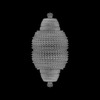




 PDBj
PDBj